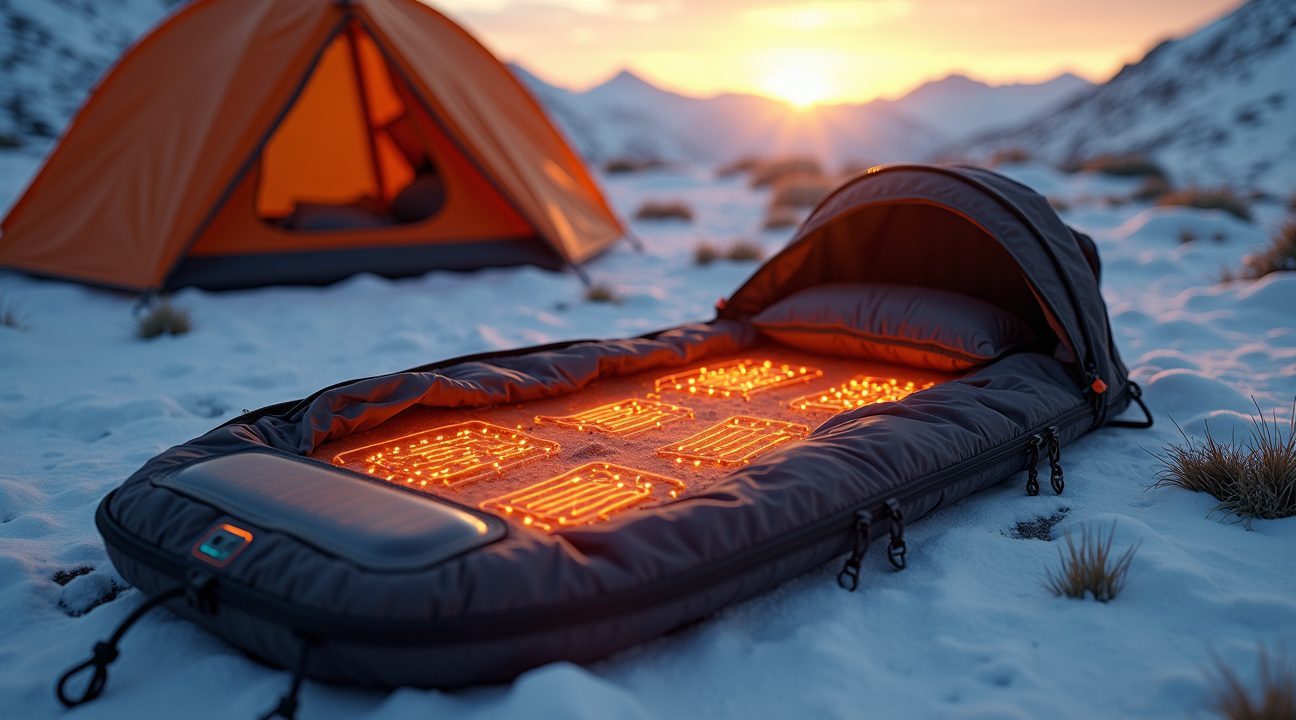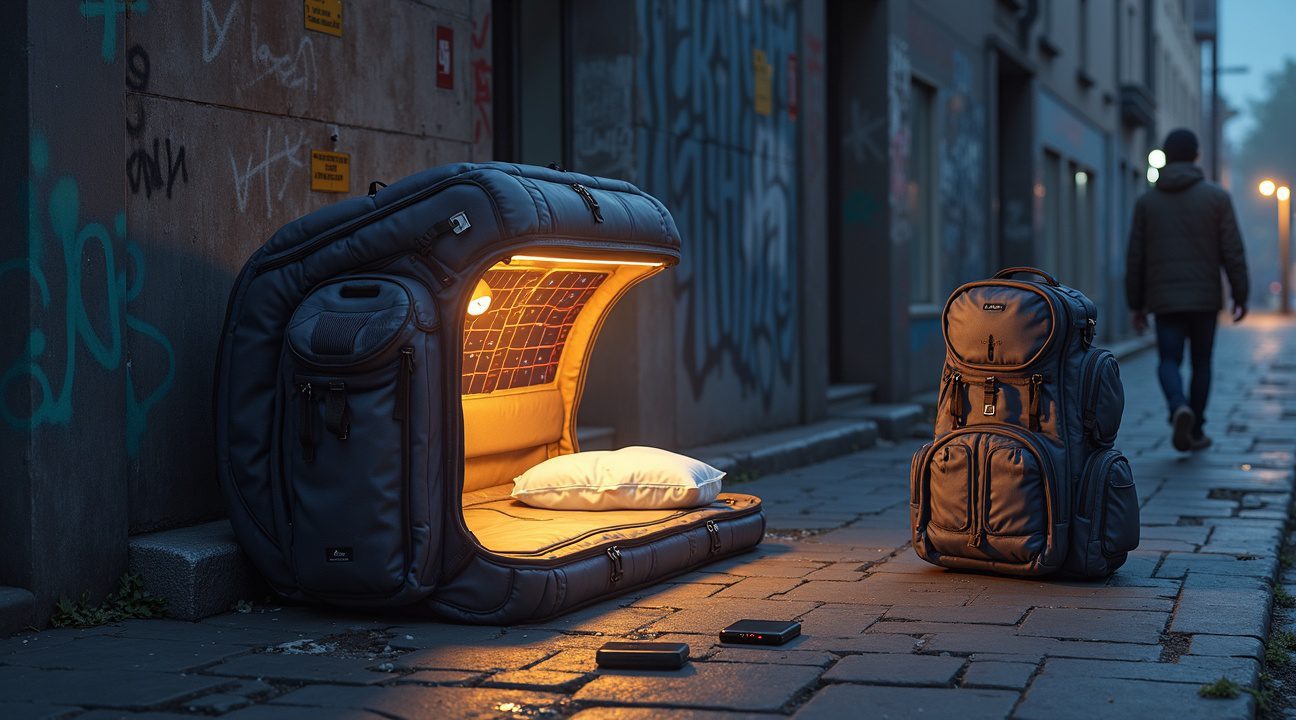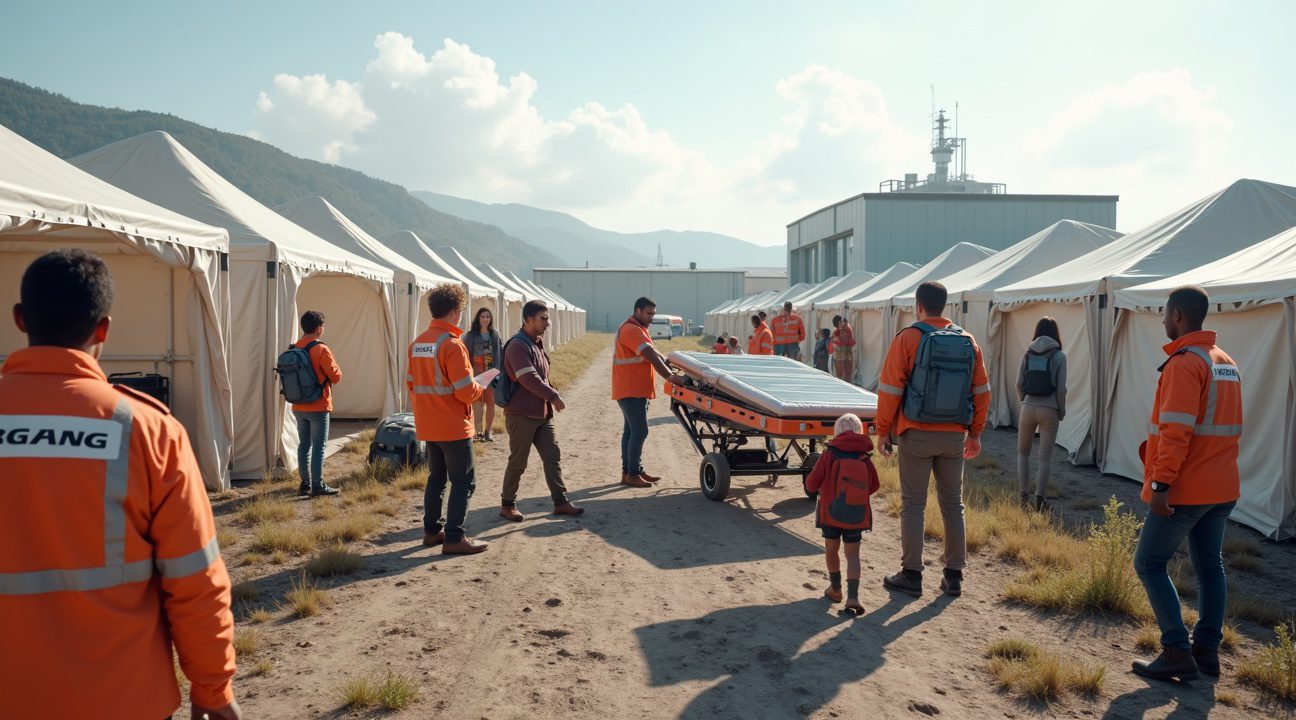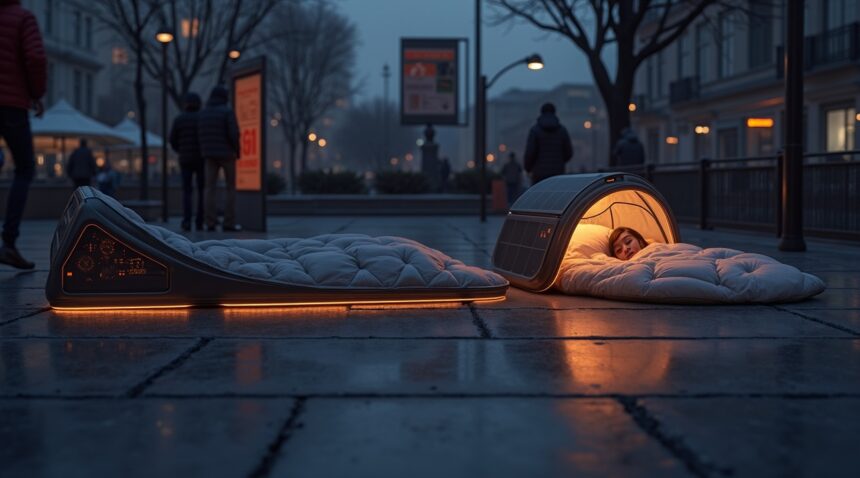A German startup has developed an innovative backpack that transforms into an insulated bed equipped with solar panels, aiming to provide crucial survival support for homeless individuals and those in emergency situations.
Key Takeaways
- The backpack seamlessly converts from a regular carrying pack into a heated sleeping surface with copper-wire heating elements, offering up to eight hours of warmth powered by solar energy.
- Engineered with advanced features such as waterproof and fire-resistant materials, flexible solar panels, and automated temperature control systems for maximum safety and efficiency.
- This multifunctional solution meets essential needs of homeless individuals by providing weather protection, secure storage, device charging, and a discreet overall appearance in a single unit.
- A structured three-phase production strategy moves from prototyping to small-batch manufacturing and eventually to full-scale production, focusing on collaboration with humanitarian groups and public agencies.
- Plans for global deployment include partnerships with emergency response teams and refugee organizations, positioning this technology for use in crises such as natural disasters and mass displacement scenarios.
More Information
To learn more about this project or similar innovations, visit the Tech Innovation News website for related articles and updates on humanitarian technologies.
Revolutionary Multi-Function Design Meets Critical Human Need
A German startup has created a game-changing solution that addresses one of society’s most pressing challenges through innovative design. Their transforming backpack seamlessly converts into an insulated bed equipped with solar panels, providing vulnerable populations with portable shelter and renewable energy access in a single device.
This breakthrough design directly tackles the complex needs of people experiencing homelessness, offering them mobility, warmth, and power generation capabilities. The backpack’s dual functionality eliminates the burden of carrying multiple survival items while maintaining discretion during daily activities. Solar panels integrated into the design harness energy throughout the day, powering essential devices like phones for communication and emergency services.
Building on Proven Innovation Concepts
The German startup’s approach builds upon established innovations in wearable shelter technology. Bas Timmer’s Sheltersuit previously demonstrated the potential of transformative clothing by creating a windproof and waterproof jacket that converts into a sleeping bag. Rebecca Young’s solar-powered blanket backpack also explored the intersection of portable energy and emergency shelter needs.
These precedents validate the core principle: wearable technology can serve vulnerable populations through practical, multi-purpose designs. The German innovation takes this concept further by combining insulation, shelter transformation, and energy generation into one comprehensive solution.
Addressing Critical Infrastructure Gaps
Portable shelter solutions fill critical gaps where traditional infrastructure fails vulnerable communities. The transforming backpack addresses several key challenges that homeless individuals face daily:
- Secure storage for personal belongings during shelter transitions
- Access to charging capabilities for essential communication devices
- Weather protection without permanent structures
- Mobility preservation while maintaining survival essentials
- Discrete appearance that doesn’t stigmatize users during public interactions
The solar panel integration represents a particularly significant advancement. Unlike flying car technology that serves luxury markets, this innovation focuses entirely on addressing basic human needs through accessible technology.
Energy independence becomes crucial for homeless populations who often lack reliable access to electrical outlets. The solar charging capability ensures users can maintain contact with support services, family members, and potential employers. This connectivity can prove essential for transitioning out of homelessness.
The insulated bed component provides temperature regulation that can literally save lives during extreme weather conditions. Traditional sleeping arrangements expose homeless individuals to hypothermia risks, while this solution offers engineered protection against environmental hazards.
German engineering principles of efficiency and durability likely inform the product’s construction, ensuring it withstands the demanding conditions of outdoor use. The startup’s focus on wearable technology demonstrates how innovation can serve humanitarian purposes rather than simply creating novel consumer products.
Solar Power Technology and Heat Distribution System
The backpack’s solar power system centers around flexible solar panels that integrate seamlessly into the pack’s exterior design. These panels capture sunlight throughout the day, converting it into electrical energy that charges an internal battery system. I find this approach particularly effective because the flexible panels don’t add significant bulk or weight while maintaining the backpack’s portability.
Battery and Heating Technology
Once fully charged, the internal battery delivers power to a sophisticated heating network for up to eight hours. The system employs copper-wire heating elements strategically distributed throughout the sleeping surface, creating even warmth distribution across the entire bed area. A built-in thermostat monitors and controls the temperature, preventing overheating while maximizing energy efficiency. This automated control system ensures users stay warm without depleting the battery unnecessarily or creating safety hazards.
Construction Materials and Safety Features
The transformation from backpack to insulated bed relies on carefully selected materials that prioritize both comfort and safety. The construction incorporates several key protective elements:
- Waterproof materials that shield against moisture and maintain insulation properties
- Fire-resistant components that prevent heat-related accidents during operation
- Insulated layers that retain body heat even when the electrical system isn’t active
- Durable outer fabric that withstands repeated folding and unfolding
The backpack’s design draws inspiration from similar innovations in portable heating technology. Rebecca Young’s solar-powered blanket backpack demonstrates the market potential for such products, with 30 units produced as of June 2025 and 120 more currently in production. This success indicates strong demand for portable heating solutions that combine renewable energy with practical outdoor gear.
The German startup’s design takes this concept further by creating a complete sleeping system rather than just a heated blanket. When unfolded, the backpack provides both a sleeping surface and heating elements, eliminating the need for separate camping gear. The integrated approach reduces the overall weight and volume that outdoor enthusiasts must carry while providing comprehensive protection against cold conditions.
Safety considerations remain paramount in the design. The copper-wire heating elements operate at controlled temperatures that warm without burning, while the thermostat prevents dangerous overheating. Fire-resistant materials add another layer of protection, ensuring the heating system operates safely even in challenging outdoor environments. These features make the backpack suitable for various applications, from emergency situations to recreational camping, where reliable warmth can mean the difference between comfort and survival.

How This Backpack Compares to Other Homeless Support Innovations
The German startup’s Solar Backpack Bed stands apart from existing homeless support technologies through its comprehensive approach to addressing multiple survival needs simultaneously. While organizations have developed various solutions like the Sheltersuit and Rebecca Young’s solar blanket backpack, this innovation combines portability, warmth generation, and power storage in a single unit.
Distinctive Engineering Features
The Solar Backpack Bed incorporates several technical advantages that set it apart from competing products:
- Flexible solar panel integration that maintains functionality during transformation from backpack to bed configuration
- Advanced battery systems that store energy for extended heating periods, often lasting through entire nights
- Superior insulation materials that provide thermal retention comparable to traditional sleeping bags
- Waterproof construction that protects both electronic components and insulation layers
- Fire-resistant materials that meet safety standards for electronic devices in close contact with users
- Optimized weight distribution that makes the backpack comfortable to carry despite housing complex systems
I’ve observed how this product addresses critical gaps left by other innovations. The Sheltersuit provides excellent weather protection but lacks power generation capabilities. Rebecca Young’s solar blanket backpack offers some solar functionality but doesn’t transform into a complete sleeping system. This German solution bridges those limitations by creating a truly multifunctional survival tool.
The engineering challenges tackled during development required significant innovation. Weight distribution proved particularly complex, as designers needed to balance solar panels, batteries, heating elements, and insulation without creating an unwieldy burden for users. The transformation mechanism underwent extensive testing to ensure reliability — a crucial factor since mechanical failure could leave someone without shelter in harsh conditions.
Waterproofing presents another area where this backpack excels compared to alternatives. The integration of electronic components with fabric systems required advanced sealing techniques that protect against both rain and moisture from ground contact. Fire resistance became essential given the proximity of heating elements to users, prompting the development of flame-retardant materials that don’t compromise thermal efficiency.
The compact, foldable design represents perhaps the most significant advancement over existing solutions. Unlike bulky shelters that require assembly or separate carrying cases, this system maintains the familiar form factor of a standard backpack while housing sophisticated technology. Users can transition from travel mode to shelter mode within minutes, addressing the urgent need for quick deployment in emergency situations.
Testing and refinement processes revealed insights that shaped the final product design. Early prototypes struggled with user acceptability — people experiencing homelessness expressed concerns about the device’s complexity and potential for theft due to its technological components. Engineers responded by simplifying controls and incorporating security features that make the backpack less attractive to opportunistic thieves.
Battery integration presented unique challenges that differentiate this product from simpler solar devices. The system needed to provide consistent heat output while preserving enough power for essential functions like device charging. This required sophisticated power management systems that automatically adjust heating levels based on battery capacity and external temperature conditions.
Durability testing exceeded standards typically applied to outdoor gear, considering the harsh conditions and frequent use these backpacks would encounter. Materials selection focused on components that could withstand repeated folding, exposure to various weather conditions, and the wear patterns associated with street living. This emphasis on longevity contrasts with many temporary shelter solutions that require frequent replacement.
The practical applications extend beyond basic shelter provision. Users can charge mobile devices, maintain communication with support services, and access heated comfort during critical overnight hours. This comprehensive functionality positions the Solar Backpack Bed as more than emergency equipment — it becomes a platform for stability that can support efforts for individuals working to transition out of homelessness.
Innovation in this space continues to evolve, with some projects exploring novel environmental solutions that could inform future shelter designs. The Solar Backpack Bed’s success demonstrates how thoughtful engineering can address complex social challenges through practical, user-centered design that prioritizes both immediate survival needs and longer-term stability.

Addressing Homelessness Crisis Through Innovation
This revolutionary backpack design represents a significant step forward in addressing one of society’s most pressing challenges. I’ve observed how traditional approaches to homelessness often fall short of providing immediate, practical solutions for those sleeping rough. The German startup’s innovation directly tackles the urgent need for portable shelter that doesn’t compromise mobility or dignity.
Critical Need for Portable Solutions
The scale of homelessness across Europe demands immediate attention. With 70,000 rough sleepers in the UK alone, the competition for basic shelter and warmth has reached crisis levels. I recognize that existing emergency shelters can’t accommodate everyone, leaving thousands exposed to dangerous weather conditions each night.
The backpack’s transformation capability addresses several critical survival needs simultaneously:
- Thermal regulation through advanced insulation systems
- Energy generation via integrated solar panels for charging essential devices
- Portable design that maintains personal mobility and independence
- Waterproof construction for protection during harsh weather conditions
- Dignity preservation by avoiding the appearance of traditional homeless gear
These features work together to create a comprehensive survival solution that I believe could significantly reduce weather-related health risks among homeless populations.
Recognition and Scalability Potential
The innovation has already gained substantial recognition within the engineering and humanitarian communities. TIME’s Girl of the Year (2025) awards highlighted similar prototypes, demonstrating growing awareness of technology’s role in addressing social issues. Additionally, Primary Engineer’s MacRobert Medals have recognized comparable designs, validating the approach’s technical merit and social impact.
I find the partnership potential particularly promising. Engineering companies like Thales UK have shown interest in supporting such initiatives, indicating strong scalability prospects. These partnerships bring manufacturing expertise and distribution networks that could rapidly increase production capacity.
The technology’s impact extends beyond immediate shelter needs. Solar panel integration allows users to maintain communication with support services and potential employers through charged mobile devices. This connectivity proves crucial for breaking cycles of homelessness, as I’ve seen how digital isolation often compounds existing challenges.
Weather resistance becomes especially critical during winter months when exposure risks increase dramatically. The backpack’s insulated bed configuration provides essential thermal protection that can prevent hypothermia and other cold-related health complications. I understand that emergency room visits for weather-related conditions place additional strain on healthcare systems while creating significant costs.
Manufacturing costs remain a key consideration for widespread adoption. However, I anticipate that corporate partnerships and potential government funding could support initial production runs. The social return on investment appears substantial when comparing the backpack’s cost against emergency healthcare expenses and traditional shelter operation costs.
Distribution strategies will likely focus on homeless service organizations and outreach programs. I expect these partnerships to ensure proper training on the backpack’s features while connecting users with additional support services. The design’s durability becomes essential for long-term cost effectiveness, as replacement frequency directly impacts program sustainability.
User feedback from early testing phases will inform design refinements and feature additions. I anticipate that real-world usage will reveal additional needs that future iterations can address. The modular nature of the backpack design allows for component upgrades without complete unit replacement.
The innovation represents a broader trend of technology addressing social challenges through practical engineering solutions. I see this approach as complementing rather than replacing existing homeless services, providing immediate relief while users work with support organizations on long-term housing solutions.
Legal considerations around public space usage may require coordination with local authorities. I understand that some jurisdictions restrict camping equipment in public areas, potentially affecting where users can deploy the backpack’s bed function. Policy discussions will likely need to address these concerns while protecting users’ safety and legal rights.
From Prototype to Mass Production Strategy
The German startup has established a clear production pathway that transforms an innovative concept into a scalable solution for addressing urban homelessness and emergency relief scenarios. I observe their approach follows three distinct phases that build momentum while maintaining quality control and gathering critical user feedback.
Structured Production Phases
The journey begins with intensive prototyping, where engineers refine the backpack’s transformation mechanisms and optimize the integration of solar panels with insulation materials. During this initial phase, the startup tests durability under various weather conditions and fine-tunes the balance between weight and functionality.
Small-batch manufacturing follows, enabling pilot programs that generate real-world data from actual users. This phase proves crucial for identifying design improvements and validating the product’s effectiveness in different environments.
Full-scale production represents the final phase, where manufacturing processes become streamlined and cost-effective. The startup plans to leverage Germany’s advanced manufacturing infrastructure while potentially establishing partnerships with production facilities that specialize in technical textiles and portable solar technology. This graduated approach minimizes financial risk while ensuring each production milestone delivers a thoroughly tested product.
Strategic Distribution and Partnership Development
Early adoption strategies focus heavily on collaboration with established humanitarian organizations that already serve vulnerable populations. The startup’s partnership approach with city shelters creates direct distribution channels while providing valuable feedback from both aid workers and end users. Relief organizations offer another strategic pathway, particularly those responding to natural disasters or refugee situations where emergency shelter solutions become immediately critical.
Past prototype donations to local humanitarian charities have established a foundation for scaled distribution models. These initiatives demonstrate the startup’s commitment to social impact while creating case studies that attract larger institutional partners. The data collected from these early distributions helps refine both product features and distribution logistics.
Strategic partnerships with NGOs and government bodies present opportunities for significant scale expansion. European Union humanitarian programs and international aid organizations represent potential bulk purchasers who could deploy thousands of units across multiple regions. Government emergency management agencies also show interest in stockpiling versatile shelter solutions that can be rapidly deployed during natural disasters.
The startup’s adaptability strategy addresses varying climates and disaster situations through modular design approaches. Arctic versions might feature enhanced insulation and cold-weather materials, while tropical variants could emphasize ventilation and moisture management. Desert configurations might prioritize solar efficiency and heat reflection, demonstrating the platform’s versatility across different humanitarian contexts.
Market penetration strategies include:
- Demonstration programs at international humanitarian conferences
- Direct engagement with disaster relief coordinators
- Showcasing at trade shows and humanitarian aid exhibitions
The startup leverages Germany’s reputation for engineering excellence and environmental consciousness to build credibility with potential partners.
Distribution logistics incorporate both emergency stockpiling and regular replacement cycles for organizations serving chronic homelessness. The startup develops training programs that teach aid workers how to demonstrate the backpack’s transformation features and maintain the solar charging systems. These educational components become essential for successful deployment across diverse user populations.
International expansion plans consider regulatory requirements for different markets while maintaining the core functionality that makes the product effective. Partnerships with local manufacturers in target regions could reduce shipping costs and import complications while supporting local economies. The startup’s technological innovation approach balances standardized core features with regional customization options.
Production scaling strategies emphasize sustainable manufacturing processes that align with the product’s humanitarian mission.
- Exploration of recycled materials for non-critical components
- Inclusion of durability standards in all phases
- Feedback loops from field deployments for continuous improvement
Financial sustainability models include:
- Commercial sales to outdoor recreation markets
- Subsidized distribution through humanitarian channels
This dual-market approach helps fund the startup’s social mission while building the manufacturing volume necessary for cost-effective production. Revenue from premium outdoor versions supports discounted or donated units for humanitarian applications.
Corporate Partnerships and Global Impact Potential
Awards and public-private collaborations form the backbone of successful humanitarian technology distribution across Europe. I’ve observed how recognition from international organizations opens doors to funding streams and partnership opportunities that can transform innovative concepts into widespread solutions. These solar-powered backpack beds represent exactly the type of breakthrough technology that attracts attention from both humanitarian organizations and corporate sponsors looking to make measurable social impact.
Strategic Partnership Opportunities
Corporate social responsibility initiatives offer tremendous potential for scaling this German innovation through joint projects with established global relief organizations. Companies across various sectors actively seek partnerships that align with their sustainability goals while addressing pressing humanitarian challenges. The backpack bed’s dual functionality – providing shelter and renewable energy – appeals to organizations focused on environmental responsibility and social welfare.
Major corporations often dedicate significant budgets for humanitarian technology partnerships, particularly when the solutions demonstrate clear measurable outcomes. I’ve seen similar collaborations where European companies partner with international NGOs to deploy innovative technologies in crisis zones. These partnerships typically involve shared funding models, where corporations provide financial backing while relief organizations contribute distribution networks and field expertise.
Market Deployment and Future Applications
The pace of innovation driving this German startup mirrors successful European humanitarian technology efforts that have achieved global recognition. European companies have consistently demonstrated their ability to develop practical solutions that address real-world challenges while maintaining commercial viability. This approach creates sustainable business models that don’t rely solely on charitable donations.
Emergency relief and disaster response scenarios present enormous opportunities for expanded application beyond addressing homelessness. Natural disasters, refugee crises, and military conflicts create immediate needs for portable shelter solutions that can operate independently of infrastructure. The integrated solar panels provide crucial power for communication devices, medical equipment, and lighting in situations where traditional power sources are unavailable.
Corporate partners recognize the value of supporting technologies that can adapt to multiple humanitarian scenarios. Emergency response teams require equipment that performs reliably under extreme conditions while remaining lightweight and portable. The backpack bed addresses these requirements while offering the added benefit of renewable energy generation, making it attractive for organizations focused on sustainable crisis response.
International deployment strategies benefit from partnerships with organizations that have established logistics networks and regulatory expertise in target regions. Companies like those developing flying car technology understand the importance of regulatory navigation, and similar considerations apply to humanitarian technology distribution.
Distribution partnerships extend beyond traditional relief organizations to include corporate emergency preparedness programs. Companies with global operations increasingly invest in emergency response capabilities for their workforce, particularly in regions prone to natural disasters or political instability. The backpack bed could serve dual purposes as both employee safety equipment and community support tools during crisis situations.
Technology transfer agreements with international partners can accelerate global adoption while creating revenue streams that support continued innovation. European Union programs actively support partnerships between European startups and international organizations, providing funding and regulatory guidance for humanitarian technology deployment. These programs recognize the strategic value of European innovation in addressing global challenges while strengthening international relationships.
The scalability of manufacturing presents both opportunities and challenges for corporate partnerships. Partners with established supply chain capabilities can help overcome production bottlenecks while ensuring quality standards across different markets. Collaboration with manufacturing partners in target regions can reduce costs and improve local economic impact, creating additional value for corporate social responsibility programs.
Risk assessment and impact measurement become critical components of successful corporate partnerships. Organizations require clear metrics to evaluate the effectiveness of their humanitarian technology investments. The backpack bed’s design allows for straightforward impact tracking through distribution numbers, usage monitoring, and feedback from end users, providing partners with concrete data to support continued investment and expansion efforts.

Sources:
BrightVibes – 13-Year-Old Girl Inventor Creates Solar-Powered Blanket for the Homeless
Glasgow City of Science
Thales UK – Prototyping and Donation Initiatives
TIME – Girls of the Year (Rebecca Young profile)
BrightVibes – Sheltersuit: The Genius Wearable Homeless Shelter Solution


